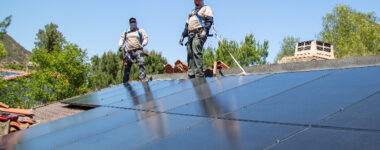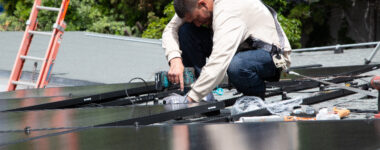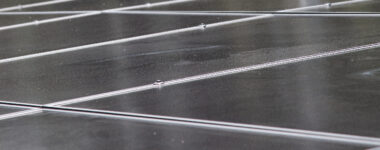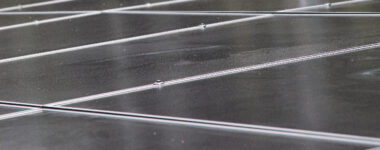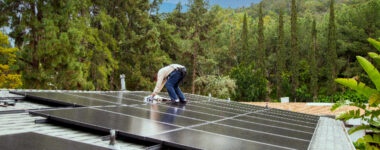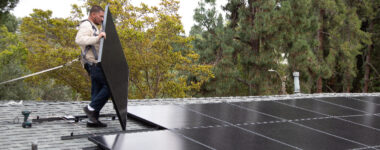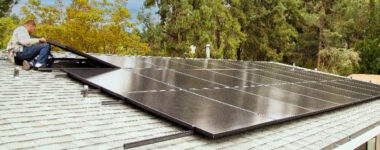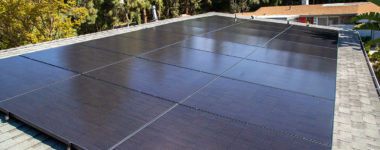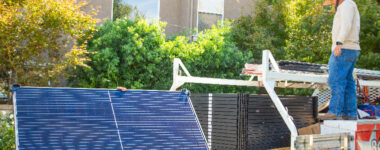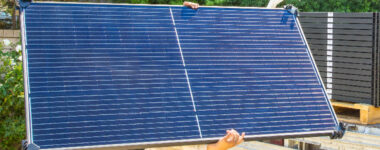Semper Solaris Blog
The White House has long served as a symbol of America, and our nation’s Presidents have been careful in how they choose to decorate and present this historic monument. Not only do the President and his staff live there, but the media also often has its eye on this important place. For these symbolic reasons, as well as a few practical ones, several Presidents throughout the years have chosen to install or uninstall solar panels on the White House roof—and by doing so, to make statements about how this powerful symbol should get its power. Jimmy Carter Jimmy (James) Carter, the 39th President of the United States, was the first President to install solar panels on the White House, and he used them to heat the water for the staff kitchen. Former President Carter’s decision was certainly a symbolic one, as the solar panels were installed during the 1979 oil crisis. He shared that this move was intentional, and in a formal declaration he stated that his goal for solar energy was, “…harnessing the power of the sun to enrich our lives as we move away from our crippling dependence on foreign oil.” Ronald Reagan The president directly after Jimmy Carter, former President Ronald Reagan, did not necessarily share Carter’s views on renewable energy. According to Scientific American, Reagan decided to remove the panels when the White House roof was resurfaced, and not to put them back up. Some of the reasons were practical, according to Reagan, who believed it was not cost-effective to keep the panels up. However, some reasons were symbolic, as this was around the same time that Reagan withdrew support for renewable energy tax credits and the Department of Energy. Carter’s panels have since been moved to Unity College in Maine, the Smithsonian Museum, the Carter Library, and the Solar Science and Technology Museum in China. George W. Bush Perhaps surprisingly, the next president to reinstall solar panels on the White House was former 43rd President George W. Bush. The administration installed a nine-kilowatt photovoltaic system to produce electricity, and two solar water heaters. Unlike Carter, Bush did not issue an official declaration or state any symbolic reasons for the switch. Instead, it simply seemed like a practical decision: solar technology had now advanced, and the solar panel price had dropped far enough, that it was now more cost effective for the White House to receive some energy from solar power. Barack Obama American’s 44th President, former President Barack Obama, reinstalled solar panels at a larger scale—and with more publicity—than anyone had since Carter. “Solar panels on the White House, I think, are a really important message that solar is here, we are doing it, and we can do a lot more,” said Dr. Ernest Moniz, former Secretary of Energy for the Obama administration. Installing solar panels on the White House was a purposeful choice for Obama, who was known for his pro-renewable energy policies. The panels installed on the White House were around the same size as panels installed on the average American home. Minh Le, Director of Solar Tech at the Department of Energy, shared, “The President is basically doing what Americans all across the nation are doing right now. They’re making the conscious choice to look for renewable energy like solar as the cheaper, cleaner, and preferred energy source for their homes and families.” Interested in installing solar panels on your own home? Get a free energy analysis from local and veteran owned Semper Solaris.
Homeowners have installed over 580,000 solar panels in California alone, saving thousands of dollars on their energy bills. Since 2007, the costs associated with installing solar panels have dramatically decreased. Best of all, the U.S. Energy Information Administration predicts solar panel prices will remain at a steady low until at least 2035. Since utility costs keep rising, now is the perfect time to install solar panels on your home. With more homeowners interested in solar energy, we’d love to help you by answering common questions. Learn more about solar panel installation and solar energy in general from Semper Solaris. Can I afford to install solar panels? We’ve come a long way since solar panels were first created. Solar panels are now more affordable than ever, and all kinds of rebates and financing programs have been created in recent years. For example, the HERO Program can help approved homeowners pay for their solar panels through their property taxes rather than through high upfront costs. There are also currently several rebates and tax incentives offered by both federal and state governments to help you create renewable energy through photovoltaic (PV) systems. In addition, many companies offer special financing or discounts. How do solar panels save me money? By using solar energy, you can lower your electricity costs or even bring them down to zero. Through a process called net metering, several homeowners with solar panels actually receive money from the electricity company for all the extra energy that they produce! For homeowners with families, who run the air conditioning often, or who run a lot of appliances and technology, solar panels can mean saving hundreds of dollars per month. In California, “grid parity” has currently been reached, meaning that the costs of installing solar panels are officially less than the costs of paying the average electricity bill each month. Also, unlike your electricity bill, your solar panel payments will eventually all be paid off. How often do I have to maintain them? One of the best features of solar panels is that they require very little maintenance. For example, at Semper Solaris we only use the most efficient solar panels on the market that come with a 25-year bumper-to-bumper warranty, meaning that they’re built to last 25 years with little to no work on the homeowner’s part. Any solar company should work with you to ensure that there are no obstructions that could decrease your panels’ ability to soak in the sunlight, but you may have to occasionally trim branches or other blockages that grow close to your roof. Solar panels don’t usually have to be cleaned in order to continue to work well, but you’re free to hose them off to keep them always looking new. What do I have to do to install solar? Most of a homeowner’s work in installing solar panels is in finding the right solar company. But once you find the contractor that’s right for you, they should take care of the rest. A good solar company will be licensed, have excellent ratings with the Better Business Bureau and Angie’s List, and will keep you well informed about the installation process. Once a solar company has the proper permits from local governments, the installation process should be very quick and simple. Where do I go for more information? Contact local and veteran owned Semper Solaris and we’ll be happy to answer your questions about solar panels—and give you a free energy analysis.
Solar Parity is a complex concept most people struggle to undertsand. That is why we created this infographic to help set the record straight. We'll try to explain the ins and outs today in the hope of helping some of you to gain a better grasp of the situation.
PG&E RATES RISE TO AN ALL TIME HIGH! If PG&E is your electric company, your rates are increasing! PG&E serves huge sections of California, including most of Northern California and Central California, as well as coastal cities like San Luis Obispo and Santa Barbara. If you live in any of these areas, you may be experiencing some of the highest rates in PG&E’s history! Starting March 2017, PG&E is adding a high usage surcharge. Do you have family members living at home during the day? Do you run your TV for most of the day or night? Or do you use an electric vehicle? All of these could put you at risk for the high usage fee! This means that those who have especially large families or many appliances, or those who just forget to turn off the lights, may be paying especially high rates. For families who may run the heater in the cold months, or who live in hotter environments and have to run the air conditioner most days, this could mean huge increases in the cost of electricity. Not only that, but PG&E is totally changing the tier system. Did your energy use ever get into Tier 3 or Tier 4? These tiers will no longer exist! Now, it’s just Tier 1, Tier 2, and the high usage fee. If you use more energy than average, you could be at risk for this extremely high rate. Right now, Tier 3 energy usage is 40 cents per kilowatt-hour, one of the highest in the country. The high usage fee is likely to be even higher than this. Tier 2 is at 24 cents per kilowatt-hour, but these will likely increase once Tier 2 and Tier 3 are combined. PG&E has also added minimum charges and fees! Electricity rates are only going up, which means there’s never a better time to go solar than now. Going solar means that you can start saving today. Solar customers can dramatically reduce or even completely eliminate their electricity bill. Why keep paying rates that only go up and up, when you can install solar panels and start saving? Some customers even receive payments from the electric company for all of their electric company! Don’t just sit back and take the ever-increasing prices—start taking ownership of your rates. Don't put it off - Go Solar and Roofing American Style with Semper Solaris, your local and veteran-owned SunPower Elite Dealer We pride ourselves on our military roots and values, and our team is known for their personal responsibility, reliable word, and faithfulness. We hire as many veterans as we can, and offer special discounts for military personnel, first responders, and their families. We also have an A+ rating with the Better Business Bureau for our customer service. Semper is also the only solar and roofing contractor still offering you the equivalent of the California state rebate, up to $3,000. Go solar with Semper. Zero down and no payments until 2018 on approved credit. Why keep paying outrageous electricity bills? Go solar now to get the best rates!
Just last month, CBS Los Angeles reported an upcoming change in Southern California’s electricity. Southern California Edison will now be charging a “high usage fee” for customers that use four times the amount of energy than the average family in the area. At first glance, this change doesn’t seem to be a concern for most Southern California residents. However, there are several groups of people that need to be especially wary of the new charge. For example, if residents have an electric car, they may hit that high usage cap much sooner than they would expect. Homes with a family member that stays at home for most of the day, or families that need to run the air conditioning or heater often, may also use higher than average amounts of electricity and get stuck with paying the new fee. CBS noted that there are several ways to approach the new fee if you believe that you may be at risk for high energy usage. For electric vehicle users, Southern California Edison offers a time-of-use plan or an electric vehicle rate plan. These plans offer lower rates for customers that charge their vehicles during specified hours, and the electric vehicle rate plan charges a different rate specifically for the electricity used to charge your vehicle. However, these plans may not work for everyone. For customers who have an electric vehicle and also run air conditioning, for example, there may be no way to escape the high usage fee. CBS Los Angeles offered solar panel installation as a possible solution, but warned that installing solar panels could mean a high upfront cost. However, for Semper Solaris, this simply isn’t true. Installing solar panels can absolutely dramatically reduce or even eliminate your electric bill, even for those who use a large amount of electricity every month. However, Semper Solaris offers zero down, no money out of pocket solar panel installation. Rather than charge an upfront cost that many homeowners can’t afford, Semper Solaris offers financing plans that can fit each family’s needs. We can also connect homeowners with several programs that offer other financing options. The HERO Program, for example is a local government-approved program that makes energy-efficient and water-saving home upgrades affordable for homeowners. HERO offers 100% financing up to your approved amount, and payments are made along with your property taxes rather than one large upfront payment. Several of Semper Solaris’ customers, even those who run the air conditioning constantly, have gotten their electric bills down to zero. Compared to the hundreds of dollars that they were paying before, they’re saving a fortune! For many homeowners, the amount that they pay, whether through monthly payments or through other options like property taxes, is actually less than they were paying for their electricity bills. Unlike electricity bills, however, solar panel payments eventually end—and from then on, homeowners enjoy one less bill and plenty of extra energy. Some families are even paid by the electric companies because they produce so much extra energy through their solar panels! There’s no reason to continue to pay for electricity. Call Semper Solaris today, and one of our experts will be happy to evaluate your home and electricity needs, and to work with you to create a solar installation plan that’s best for you.
Congress passed a law that created the National Aeronautics and Space Administration on July 29, 1958. NASA was created to be a civilian agency with the job of coordinating America's activities in space. Since this time, NASA has been in charge of many different expeditions into space. Some of these expeditions involved human astronauts, while others were performed with computers and machines. Thanks to NASA's work, satellites have been sent into space that help us to explore the solar system, forecast the weather, and communicate in faster ways. The Cold War and the Space Race During the 1950s, the United States and the Soviet Union were military rivals. At the same time, the two countries engaged in a competition that has become known as the space race. Each country tried to outdo the other in many ways, and when it came to science, space exploration was the focus. On Oct. 4, 1957, the Soviet Union launched Sputnik I, which was the first satellite to be sent into space. This satellite weighed a little more than 183 pounds, and it went around the Earth in a space trip that took 98 minutes. The United States was surprised by the Soviet Union's launch of Sputnik I, and the world was excited about this event. Less than a month later, the Soviet Union launched Sputnik II, this time sending a dog into space. The Soviets knew that they had no way of returning the dog to Earth, and their plan was to keep it comfortable with food and water until it ran out of oxygen after about 10 days. But temperatures inside the aircraft were higher than 100 degrees Fahrenheit, and the dog only survived for about two days. NASA launched the first American satellite on Jan. 31, 1958, called Explorer I. Explorer I's main job in space was to measure the radiation present in Earth's orbit. Explorer I orbited around the Earth one time every 114.8 minutes, making more than 12 orbits a day. After it finished its work, it returned to Earth's atmosphere on March 31, 1970, burning up as it fell. Memorable Achievements Apollo 11 landed on the moon on July 20, 1969. Pilot Buzz Aldrin landed the lunar module, called the Eagle, and Neil Armstrong was the first person to walk on the moon. Aldrin and Armstrong spent about a day exploring the moon. In 1975, scientists began working on a special telescope that would be able to get a clear view of space, unobstructed by the water and gases that surround Earth. This telescope is named after Edwin Hubble, an astronomer. After 15 years, scientists finally launched the telescope. Through the Hubble Space Telescope, people can see parts of the universe that are billions of light years away. Pioneer 10 was a spacecraft that left Earth in 1972, bound for Jupiter. Pioneer 10 made it to Jupiter, recording data about the planet, and then it kept going. It left the solar system in 1983 and traveled into interstellar space. Designing and inhabiting the International Space Station has also been an extraordinary accomplishment, not only for the United States but also for Russia and other countries. Astronauts have spent hundreds of days aboard the International Space Station, studying space and how humans respond to extended periods without gravity. Space Shuttles Initially, the spacecrafts designed by NASA were built to be used just one time, since scientists had not yet figured out how to get them back down to Earth without destroying them. Designing reusable spacecrafts was an important achievement. The goal was to make some kind of heat shield that would protect the vessels from the high temperatures that come with re-entering the atmosphere. Then, there was also the problem of getting the spacecraft back down to Earth and landing it in one piece. In 1981, the space shuttle Columbia flew a successful mission as the first reusable spacecraft. Satellites Using satellites that NASA has put into orbit around the Earth, scientists can get real-time images that help predict the weather. Satellites have also revolutionized the way people communicate around the world. An intricate web of telephone circuits has enabled people to communicate easily and relatively inexpensively. Satellites also make it possible for TV and radio channels to broadcast worldwide. Newer types of satellites enable cell phone service. A Brief History of NASA This Day in History: NASA Created Learn About the History of NASA Space Exploration Timeline Top NASA Photos of All Time Early Space History NASA's Apollo Technology Has Changed History History of the NASA Skylab, America's First Space Station
530 students from school districts across California are scheduled to take part in learning about solar energy. Nearly 1,000 students and more than 110 teachers have participated in this program since it was launched in 2012; the enrollment rate for this year’s program is nearly double that of last summer’s. The program is delivered over the course of one week in each participating region, immersing high-school students in a curriculum of projects and activities structured around the acronym STEM: science, technology, engineering, and mathematics. Students and teachers are teamed with solar industry professionals in laboratory work and field trips to California solar installations. The program concludes with the students presenting their knowledge to a panel of solar industry representatives, school board members, teachers, and community leaders. “As solar power plays an increasingly critical role in meeting global energy demand, students participating . . . may be the engineers and business leaders charting our energy future.” “In the process of learning about solar technology and energy solutions, the students’ enthusiasm and ability to understand complex concepts is very inspiring. Solar power is proud of the increasing number of participants interested in solar power.” The 2016 schedule started with thirty-six students and teachers from Pajaro Valley Unified School District (PVUSD) joining STEM instructors and California solar professionals at Cabrillo College in Watsonville, California to learn about residential solar power systems. “This is the third year we are offering this program to our students and staff, and we’re excited to get started,” said PVUSD Assistant Superintendent Susan Perez. “[our solar energy education program] brings relevant and real-life knowledge into the classroom, while preparing students for the challenges of the 21st century. We’re proud to support the development of our districts young people with this valuable STEM curriculum during the summer months.” Other Northern California districts taking part in this summer’s academy include Antioch, Benicia, East Side Union, Fairfield-Suisun, Mount Diablo, Napa Valley, Oakland, Pittsburg, San Jose, San Rafael City, San Ramon Valley, Tamalpais Union, Travis, Vacaville, Vallejo, Novato, and West Contra Costa. Central Valley districts enrolled in the program include Dinuba, Kern, Lindsay, Lemoore, Orosi, and Porterville. In Southern California, the districts of Santa Ana, Colton, Fontana, Grossmont, Moreno Valley, Oxnard, Rialto, and San Bernardino City are all participating. In twenty-three districts, the solar power has been installed more than ninety megawatts, which, according to the Solar Energy Industries Association, generates an amount of power equivalent to that of 22,500 average Californian homes. In 2014, The Solar Foundation estimated that over 3,700 K-12 schools in the States have solar power installations onsite, serving nearly 2.7 million students across the nation and saving approximately $77.8 million in annual electricity costs. Receive an instant text quote in seconds and see how much you can save on our highest efficiency solar panels.
At 2:30 a.m. EST on June 20, 2016, a plane called Solar Impulse 2, piloted by a man named Bertrand Piccard and powered solely by 17,000+ solar cells, took off from New York City and began a ninety-hour journey across the Atlantic to Seville, Spain. This is but one stretch of the plane’s circumnavigation of the globe to land in Abu Dhabi. The story of this remarkable craft is recounted below. The American designed solar cells that were chosen as the provider for this project produce more efficient and durable solar cells than any other solar cell on the market, and this isn’t their first high-concept collaboration. There was Honda, with whom they won the 1993 World Solar Challenge, a 1,800-mile race of solar vehicles across the Australian outback from Darwin to Adelaide. Twenty years later, an autonomous NASA vehicle named GROVER rolled onto the scene and surveyed Greenland’s frigid icecap. The same technology used in these landmark machines is found in residential, commercial, and power plant solar panels. In 1999, Bertrand Piccard and Brian Jones became the first pilots to successfully fly a hot-air balloon continuously around the globe. Upon touching down in the Sahara after more than two weeks in the air, Piccard’s vision—to fly around the world without relying on fossil fuel—first took shape. Soon Piccard and fellow pilot Andre Borschberg founded the Solar Impulse project and set to work researching new developments in solar flight to find a solar energy company worth partnering with. It wasn’t long before they discovered a solar manufacturer that worked with NASA on two flights (Pathfinder Plus and Helios) in the late ’90s. The solar cells developed for these projects were light, flexible, and thin without sacrificing efficiency or reliability. Four years later, a coalition of thirty engineers and twenty-five technicians completed a prototype craft, which boasted the wingspan of an Airbus A340 at a fraction of the weight. 12,000 solar cells were embedded in the wing surfaces, while a flexible, high-resistance film coated the undersides. Solar Impulse 1’s first landmark flight was on July 7, 2010, when it was flown for twenty-six hours straight. It went on a historic run from there, setting eight world records as the first solar aircraft to fly straight through the night, to fly between continents, and to cross the United States, among other accomplishments. Many improvements had to be made for Solar Impulse 2 to make it across the world’s vast oceans. The team’s to-do list included: improving performance and fuel economy; refining the ergonomics of the cockpit; safety improvements including leak-proof circuits for humid conditions and finally, making the plane as light as possible. Solar cell manufacturers have been improving their technology as well, producing cells even thinner and lighter than before. The result was Solar Impulse 2, which began its journey on March 9, 2015 in Abu Dhabi. Its daily routine is to rise in the mornings as high as 28,000 feet, taking energy from the Sun to store in its lithium batteries. As night falls, it descends and glides at a lower altitude until dawn. The plane broke world records last summer, when Borschberg flew it from Japan to Hawai‘i, only touching down for battery repairs. Piccard’s drive to excellence can best be summed up by a comment he once made in a TED talk: “People will tell you it’s impossible, and it’s exactly why we try to do it.” Later, Borschberg helped make the connection to the mission to change the way the world is (em)powered: “To fly with the Sun, day and night, we had to build an aircraft that is extremely energy-efficient. These technologies that provide energy efficiency can be used in your home, in your car, in the appliances that you buy.” We at Semper Solaris salute your accomplishments thus far, Solar Impulse, and will do our part to further the cause in the California solar power industry. Receive an instant text quote in seconds and see how much you can save on our highest efficiency solar panels.
It’s no secret that the United States needs oil. In 2012, according to the U.S. Energy Information Administration, the United States consumed an average of 18.6 million barrels per day of oil and petroleum products. Further, in that same year, around 40% of net imports of oil were from foreign sources. This indicates that the United States is partially dependent on trade with other nations in order for our country to thrive, especially when it comes to oil, and this can ultimately be dangerous. The U.S. Department of Defense is also reliant on oil, which could be problematic if we are reliant on a single source of energy. With other options, such as an increase in the use of solar energy or other renewable avenues, the military and America itself may have other choices instead of oil. Without that reliance, if anything were to happen to our foreign oil supply, citizens and military personnel alike would not be nearly as at risk. Another issue with reliance on oil is the nature of the energy supply. If we rely on physical resources, we will have physical locations that are at risk. Coal mines or oil refineries are large and isolated and would be an excellent target for threats. Comparatively, solar panels can be widely distributed to individual homes, buildings, or businesses—and if one is compromised, the rest still stand. The military has already noticed the potential benefits of renewable resources like solar energy and has been making the switch. According to Executive Order 13693, the federal government is committed to having 30% of their electricity come from renewable energy sources by 2025. As of 2014, renewable energy sources accounted for about 8.76% of the federal government’s energy consumption. Even the Commander in Chief has made changes and had solar panels installed at the White House. As President Obama and our federal government have indicated, it can be a wise step in the direction of national security and ultimately of energy security to invest in solar energy and other renewable resources. Especially here at Semper Solaris, where we have deep commitment to and experience with the military, we look forward to see the steps that the military makes in favor of diversifying its energy options. Receive an instant text quote in seconds and see how much you can save on our highest efficiency solar panels.
While humanity has enjoyed the Sun and used its warmth and light since we began to exist, it wasn’t until the last few hundred years that we were able to harness the Sun’s energy for electricity. The development of solar energy technology first began with observations, and then it became a continuous process of developing useful technology based off of these observations. One of the most important discoveries began in 1839. In a decade where the United States was only twenty-six states large and the sewing machine just began to be used, Alexandre Edmond Becquerel observed something interesting. He noticed that some materials, when exposed to light, would produce small amounts of electric current. Becquerel experimented with this for a while, and documented his discoveries. Thirty-seven years later, William Grylls Adams and his student Richard Evans Day refined this discovery with the observation of selenium. Selenium produced energy when exposed to light, and these two men created a photovoltaic cell to harness and convert this energy into usable electricity. However, it was only a small experimental cell and not easily reproducible or cost efficient. It only produced electricity at 1-2% efficiency. It was over 100 years later, in 1954, that solar power became a real possibility. Researchers at Bell Laboratories patented the first practical solar cell, using silicon rather than selenium. The next year, these solar cells began to be sold. Though they were only 2% efficient, compared to an average of 18% efficient today, these sold for $1,785 per watt in the equivalent of 1955 dollars. In the 1960s and 70s, however, solar power began to be more practical. Efficiency levels grew to close to 10% with new technology, and the idea of renewable energy was becoming more and more popular. Further, space exploration was becoming a greater priority, and solar technology seemed like a useful alternative energy source for space travel. Solar-powered calculators and watches entered the scene. By the 1980s, solar power was readily available to citizens, and federal acts gave incentives and tax credits to installing renewable energy in homes. In 1983, sales of solar cells exceeded $250,000,000. History since the 1980s has seen continuous growth of the pervasiveness and quantity of solar energy technology. Countries around the world have instituted bills and laws to help provide solar energy for their citizens, and technology is only becoming more and more efficient and refined. Further, solar is much more readily available than it was when it first began. While prices used to be $1,785 per watt, they’re now predicted to be below $1 per watt by 2020. Solar technology may have had a slow start, but it’s quickly becoming one of the most significant areas of technological advancement in our history. Get a FREE estimate, and see how much you can save on our highest-efficiency solar panels.
Solar cookers are devices that use energy directly from sunlight to heat or cook food and drinks. There are many different styles of solar cookers that are currently in use and most are low cost, low tech devices. There are however some solar cookers that are extremely advanced and powerful and can cost as much as a traditional oven. Solar cookers are environmentally friendly as they do not use fuel or need electricity to operate. Because of this, many organizations promote the use of solar cookers to reduce air pollution and fuel costs as well as slowing deforestation caused by gathering wood for cooking. Solar cooking is often used in areas where the risk of fire accidents is high, or where the minimal consumption of fuel is important. How Solar Cookers Work Different types of solar cookers generally follow the same basic principles of operation but can vary slightly depending on the type of cooker in use. Typically, food for a solar cooker is prepared the same way as it would be for a traditional oven. It is recommended that food to be placed in a solar cooker be cut or broken into smaller pieces, allowing it to cook faster. For simple cooking, food can simply be placed in a bowl or on a tray, uncovered. If you are cooking several foods that need to be separated, then they are placed in several different containers. The container of food is then placed in the solar cooker. The solar cooker can be elevated on a metal trivet, rock, or brick, and should be placed directly in the sunlight. If the cooker is placed correctly, then the shadow of the cooker will not overlap with the shadow of any objects nearby. Solar cookers are simply placed in direct sunlight and left to work until the food is finished cooking unlike cooking over a fire or on a stove which can require constant supervision. Generally, it is unnecessary to stir or turn food in a solar cooker as it can cause heat to escape which can increase cooking time. Cooking times can vary depending on the performance of the solar cooker in addition to local weather conditions. Types of Solar Cookers Box Cookers - Box solar cookers have transparent tops made of either plastic or glass and can have added reflectors to help concentrate the sunlight. Box cooker tops can generally be taken off to allow containers of food to be placed inside. Shiny metal reflectors or foil can be positioned to help concentrate extra sunlight into the box. The food containers used with box cookers are dark in color and the box has insulated sides. If building a box cooker, thermal insulation should be used that can withstand high temperatures without melting. Box cookers will usually reach about 300 degrees Fahrenheit. Panel Cookers - Panel cookers are very inexpensive and have reflective panels that direct sunlight to a container of food that is placed in a clear, sealed plastic bag. This is the type of solar cooker that is often used in science experiments as it can easily be made at home with common household materials. Parabolic Cookers - Parabolic cookers work by concentrating the sun's rays to a single point that focuses on the bottom of the pot holding the food. Parabolic cookers can heat containers very quickly to temperatures comparable to those of charcoal and gas grills. Parabolix cookers are used in many areas of the world. In India and China, parabolic cookers are used for heating water and preparing food. It has been estimated that the use of parabolic solar cookers in China have abated between one and four tons of carbon monoxide per year since they started being widely used. Advantages and Disadvantages of Solar Cookers There are several advantages and disadvantages to using solar cookers to prepare food. Advantages Parabolic solar cookers can make food within minutes. Box cookers can prepare most foods and sterilize water in a matter of hours. Solar cookers do not use fuel, making them an environmentally friendly option. Solar cookers are used outside, meaning that they do not contribute to heat inside which could possibly save on cooling costs and make for less cleanup. Solar cooking requires less hands-on time during the cooking process. Disadvantages Solar cookers are not as useful when the weather is overcast or when the sun is low in the sky. Some solar cookers take much longer to cook food than it would with a traditional oven. It may be necessary to learn new techniques for cooking foods such as fried eggs. Certain solar cookers can be affected by wind, slowing down the cooking process and cooling the food. More on Solar Cookers Solar Oven Activity Solar Cooking 101 About Solar Energy Build a Pizza Box Solar Oven Solar Cooking Recipe Cook With the Sun - Solar Oven Recipes How Solar Cooking Works Local Solar and Roofing Installation & Repair Bay Area Companies Orange County Companies Solar Power in San Diego Los Angeles Solar Panel Redlands Solar Company
Have you been thinking about investing in solar panels for your home? Solar energy is a prime example of clean energy. It relies only on the power of the sun to produce electricity. “Clean energy” is a term that describes energy produced without pollution. On average, a single home solar panel provides roughly 3,400 kilowatt-hours of electricity per year, all without producing pollution. Homes with solar panels are valued higher on the real estate market, and homeowners can significantly reduce their utility bills by installing solar panels. Still not convinced? Learn more about the benefits of having solar panels for your home. Understanding the Benefits of Installing Solar Panels for Your Home The primary barrier to the widespread adoption of residential solar energy is the cost, which can be in the tens of thousands of dollars per home. But according to a study by the Lawrence Berkeley National Laboratory, the price of solar installation is dropping fast. The median price of an installed solar power system fell by 60 percent over a span of 15 years, from $12 per watt in 1998 to $4.70 per watt in 2013. This price adjustment is before any incentives, such as government rebates or tax breaks, are factored into the cost. The declining price of solar energy is due to increases in the efficiency of production as well as the amount of power a solar cell can produce. In addition, many homeowners who install solar energy systems will be eligible for government tax credits and rebates that will lower the cost even more. Solar panels require very little maintenance and can last between 25 and 45 years because they have no moving parts. The benefits of switching to solar power are numerous, and they include reducing current levels of pollution, lowering electric bills, gaining a higher home resale value, and, in some cases, benefiting from a self-sufficient home power grid. A home that relies to some degree on solar power is inherently reducing its pollution footprint. Solar panels for your home do not burn any fossil fuel, as they rely only on sunlight to produce electricity. Solar power does not produce any harmful emissions, such as greenhouse gasses, and does not contribute to global warming or acid rain. Replacing the traditional system of power plants with solar panels would reduce the cases of respiratory and even cardiovascular illnesses that occur due to air pollution. In addition, solar panels lack the moving parts found in wind energy systems, which means that solar power also does not present any threats to birds. As a homeowner, you can significantly reduce your utility bills by installing solar panels for your home. Depending on the area, homeowners may also be able to sell some power back to the utility grid if their solar panels produce more than their household uses. Home energy prices have risen an average of 3 percent per year since 2002, while solar panels have dropped in price, making solar power an increasingly competitive option compared to relying on utility companies. And solar panels for your home can reduce the cost of energy for everyone, including neighbors who do not have solar energy. Using solar power drives down the demand for electricity from the grid, especially during the summer, when the cost per kilowatt-hour and demand for electricity are the highest. Furthermore, in areas where solar-powered homes contribute electricity to the grid, it enables utility companies to draw power from these cheap sources rather than turning to more expensive power plants. According to a Boston University study by professor Robert Kaufmann, solar-powered homes currently deliver a price drop of one cent per kilowatt-hour in Massachusetts, where the average cost per kilowatt-hour is 15 cents. A home with solar panels will sell for a higher price than other homes that do not have them. According to a study done in January 2015 by the Lawrence Berkeley National Laboratory, the sale price of a home with a solar array goes up by an average of $15,000. That figure comes out to an additional $4 of resale value per watt of power produced by the installed solar energy system. This resale value pertains primarily to homes with panels that have already been fully paid for. Homes with solar panels installed enjoy a varying level of energy independence. Inherently, these homes will enjoy strong protection from utility cost increases. Depending on the utility, a home with solar panels may also become a generator of electricity by selling power back to the grid. Homeowners will often also install batteries that can store electricity for use when it’s cloudy or during power outages. Although this option is more expensive, a sufficiently powerful system of batteries and solar panels can enable a home to run without relying on the grid at all. Are you ready to invest in solar panels for your home? Contact your local California solar power provider. Protecting the Environment Energy, Economic, and Environmental Benefits of the Solar America Initiative (PDF) Renewable and Alternative Energy Energy From the Sun Reducing Energy Bills Solar Energy Solar Power Saves Everyone Money Reduce Your Energy Costs Increasing Property Value Solar Energy Resources for Homebuilders Energy Independence How Many Solar Panels Do I Need on My House to Become Energy-Independent? Solar Panel Installation Costs Tracking the Sun (PDF) Going Solar in America (PDF) Solar Power for Your Home: A Consumer’s Guide (PDF) Should You Put Solar Panels on Your House? Solar Companies Solar Orange County Solar Companies Bay Area Solar Panels Solar Panel Companies San Diego Solar Panel Installation Best Price Solar Solar Panel Installs
Solar power is one of the most plentiful renewable energy sources in the world, especially in areas such as California that enjoy the benefits of clear skies on a regular basis. Some people may be resistant to the idea of solar power because they simply don't understand how solar panels work. However, solar power is a solid choice for residents in the San Diego area. If you're not sure how solar panels work, you've come to the right place. The Rundown on Solar Power In short, solar power provides electricity for homes and buildings. It is so effective that it can be used in place of traditional electricity or other sources of energy. The word “solar” comes from the Latin word for “sun.” “Solar power” refers to the powerful energy we get from the sun. Thousands of years ago, people realized the power of the sun, and even then, people tried to use solar power to make their homes more comfortable in the winter. It’s a reliable, eco-friendly energy that doesn’t run out and doesn’t create pollution the way some sources of energy, such as gas or coal, can. Today, especially in California, solar power is a fitting source of energy, thanks to the state’s conducive climate. Harnessing Solar Energy in California As the sun shines down on the Earth, different areas can collect different amounts of solar power. San Diego, California, for example, is a warm and sunny city that gets a lot of intense sunlight throughout the year. In fact, all of Southern California is an ideal place for solar energy collection. California solar power companies in this area use solar thermal collectors, which absorb heat energy from the sun. This energy is then used to heat water or make electricity. If a system is big enough, the cells that turn sunlight into electricity can even make enough electricity for a whole neighborhood. An area that’s open to the sky and without too many trees overhead is needed to collect solar energy. Solar Energy Four Ways to Do Solar Energy Solar Energy Technology Basics Solar Power Saves Everyone Money How Solar Panels Work Solar panels are set up so that the sun shines down on them at an ideal angle. When the sun hits the panels, tiny solar cells, also called photovoltaic cells, absorb the sunlight. These cells might be as small as a half an inch or as large as 4 inches each. The solar cells then absorb the energy and use it to move electrons to a second layer of the cells. When the electrons hit the second layer, this action forces other electrons to move down, too. This movement of electrons is actually electricity, which can power appliances in a house. In the United States, California solar power is prominent due to the abundant sunshine and heat in this area. California was early to adopt the solar power movement. For example, the Mojave Desert in southern California has a solar power plant that has been running for decades. Solar Energy How Solar Panels Work: A Simple Explanation The Environment: Solar Energy How Does Solar Power Work? Renewable Energy Sources Solar Power Learn About Solar Power How You Can Use Solar Energy in the Home Whether you live on the coast, inland, atop rolling hills, or in the mountains, California residents in all regions can find multiple uses for solar energy in the home. With solar panels, you can collect solar energy to use for air conditioning, to heat water, and to power appliances. A battery can store extra energy so that the house can have power at night and on cloudy days, like those signature “May Gray and “June Gloom” months sunny SoCal often experiences. Solar Basics Solar Power Facts DIY Projects Using the Sun A Kid’s Guide to Solar Power in the Home Meet the Sun Power People Should You Put Solar Panels on Your House? Kids Can Learn About Solar Power Educating Children About Solar Some Solar Energy Fun California solar power is leading the future of energy. Want to learn more about solar energy? Activities like building a solar oven with a box, aluminum foil, and a few other materials can show you how to use the power of the sun to cook a fun snack. You could build a solar night-light out of a jar and a solar path light. Try out the following games, experiments, and activities to get a hands-on experience with solar energy. Solar Energy Coloring Book (PDF) How Solar Panels Work (video) Energy Games and Icebreakers Energy City Interactive Game California Solar Power Regions Served by Semper Solaris Take a look at the top locations we serve in California to find out more information about your city. San Diego Solar Orange County Solar Bay Area Solar Los Angeles Solar Inland Empire Solar If you’re interested in learning more about how solar panels work and how solar panels for home use can benefit you, contact a specialist such as Semper Solaris today.
In the state of California, solar power is becoming more and more popular. In fact, cities like San Diego have embraced solar power completely, and California solar energy users outnumber those in other states by a wide margin in many cases. Out of the top 10 solar-producing cities in the country, four of them are among California solar producers, and San Diego has been recognized as the leading solar-producing city in America. There’s no denying that California solar power leads the way in alternative energy production. Semper Solaris is proud to service San Diego, the leading city of solar power production in the United States. If you’re considering solar panels for home use and you live in the San Diego area, join the countless others who have already made the switch to California solar energy. Check out Semper Solaris to find out what a solar installation for your home could look like. Semper Solaris Services & Resources solar company san diego || solar installation los angeles || solar bay area || solar power palm springs || solar power orange county || free energy analysis
From businesses to homes, solar panel technology is used in numerous settings and industries. Beyond our planet, NASA uses solar panels on its satellites. These solar panels are produced by the same manufacturers that we at Semper Solaris use for our solar panel installations! Semper Solaris installs the finest solar panels on all of our installations We’re proud to be the recipient of multiple national solar power dealer awards. We choose only the best solar panels for good reason. If you’ve ever worried about the durability, efficiency, and effectiveness of solar panels, then you haven’t seen them in action. NASA’s Uses for Solar Panels NASA has used solar panels to explore the ice caps of Greenland, test the solar power capabilities of unmanned vehicles (crafted to explore distant planets like Mars), and create new possibilities for solar-powered aircraft. NASA used solar panels for a project in May 2013, GROVER (Goddard Remotely Operated Vehicle for Exploration and Research). Also known as the “Greenland Rover,” GROVER was operated entirely by solar energy. It received GPS coordinates from operators in Idaho, about 3,000 miles away from its location at the highest point of Greenland. Roughly 800 pounds, it was equipped with American-designed solar panels.GROVER was used to gather data in environments that would have been difficult or impossible for humans to work in. It used advanced radar technology to scan the depths of the ice and gather information. In the ice caps of Greenland, GROVER’s solar panels endured 30 mph winds and frigid temperatures as low as -22°F. Yet, for its five-week trial run, GROVER gathered its data, sustained by the ever-durable American-designed solar panels. GROVER wasn’t the only time NASA relied on American-designed solar panels. Not surprisingly, NASA experimented with drones (then called “Unmanned Aerial Vehicles,” or UAVs) long before they became available and popular in today’s market. One of these UAVs was named the Pathfinder Plus, and it was remotely piloted and powered by American-designed solar cells. In 1998, Pathfinder Plus set an altitude record: 80,201 feet. Many commercial airlines don’t fly far above 36,000 feet, which is less than half of the record for this unmanned aircraft! Another project culminated in 1999 when NASA worked together with Helios, a second-generation high-altitude, long-endurance (HALE) project, using similar unmanned vehicles. The panels were re-engineered into customized solar cells for Helios in order to create solar cells that would be able to survive the high air pressure of high altitudes and still create enough energy. These cells were also engineered to be as light as possible and to capture any and all scraps of light, even specifically light reflected off of clouds. In 2001, these new cells were efficient enough to enable Helios to set a new world record of over 96,000 feet. Efficient, American-Designed Solar Panels If solar panels designed in the US are the best option for NASA, they can be the best for your home or business. They’re efficient enough to capture light that reflects off of clouds and durable enough to withstand Greenland’s ice caps. Chances are, they’ll last long and work well on any sunny California rooftop!
